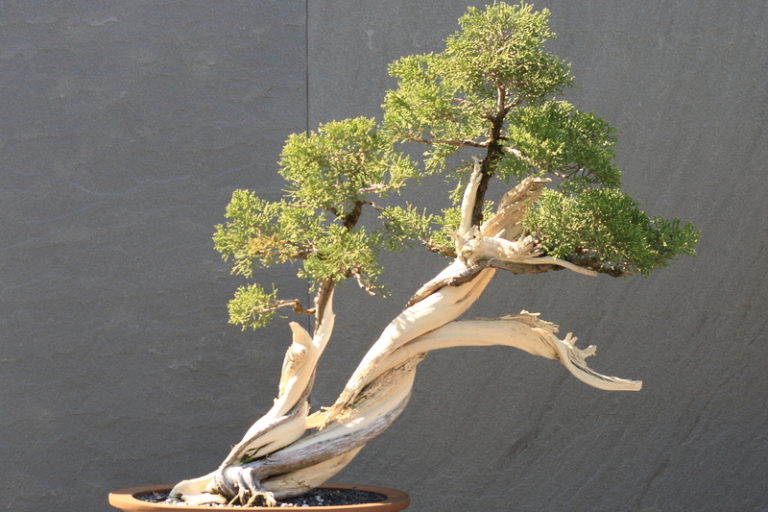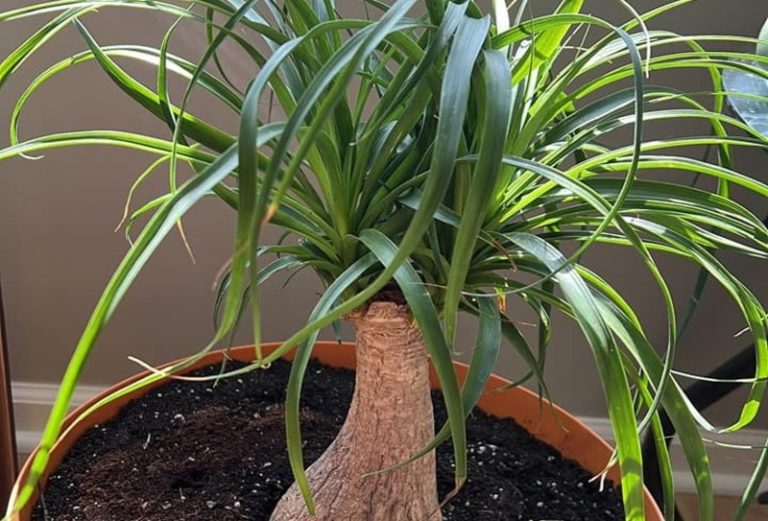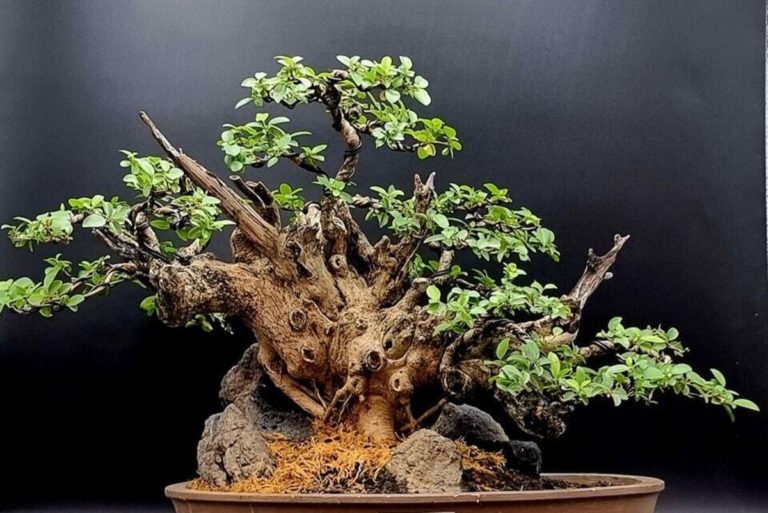Sea Green Juniper Bonsai: Elevate Your Bonsai Collection with Its Graceful Presence
Bonsai trees have captured the hearts of many nature enthusiasts around the world. One such captivating variety is the Sea Green Juniper Bonsai. In this article, we will explore the charm and allure of Sea Green Juniper Bonsai and provide you with essential tips on caring for this enchanting miniature tree.
What is a Sea Green Juniper Bonsai?
A Sea Green Juniper Bonsai is a miniature tree that belongs to the Sea Green Juniper species. It is specifically cultivated and trained in the art of bonsai, which involves shaping and miniaturizing trees to create beautiful, compact versions. The Sea Green Juniper Bonsai is known for its vibrant green foliage and delicate appearance. It is a popular choice among bonsai enthusiasts due to its unique characteristics and aesthetic appeal. The bonsai tree is carefully nurtured to maintain its miniature size while retaining the natural beauty and charm of the Sea Green Juniper species.
History and Origins of the Sea Green Juniper Bonsai
The background of the Sea Green Juniper Bonsai can be tracked back to the art of bonsai itself. Bonsai started in China over a thousand years ago, but the Japanese took it over and made it better. Bonsai, which literally means “tray planting,” is the art of growing and shaping small trees in pots. It is an old gardening method that requires patience, accuracy, and a deep respect for the beauty of nature.
The Sea Green Juniper species (Juniperus chinensis ‘Sea Green’) is native to East Asia and has been cultivated for centuries. Junipers, in general, have a rich history in bonsai cultivation due to their hardiness, adaptability, and attractive foliage. The Sea Green Juniper, with its fine-textured, dense foliage and striking green color, became a sought-after choice for bonsai enthusiasts.
During the Kamakura time (1185–1333), the art of bonsai moved from China to Japan, where it became a huge hit. Japanese bonsai masters improved the skills and looks of bonsai by coming up with different ways to shape and take care of these small trees.
The Juniper Sea Green Bonsai became a favorite among bonsai fans in Japan and around the world because of its beautiful shape and leaves. It was a good choice for growing as a bonsai because it was small and could handle being pruned and shaped.
Over time, the art of bonsai and the number of people who liked Sea Green Juniper Bonsai grew all over the world. Bonsai fans from all over the world took up the art form and added their own cultural inspirations and methods to it. Today, bonsai fans all over the world continue to admire and grow Sea Green Juniper Bonsai, which is a sign of how beautiful and artistic this old gardening tradition is.
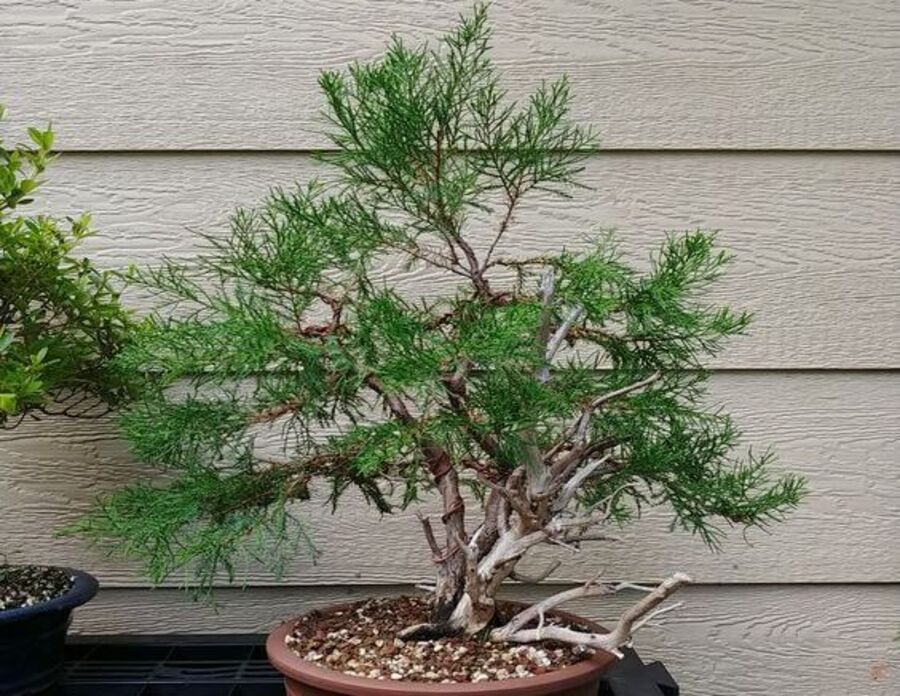
Types of Sea Green Juniper Bonsai
There are various types and cultivars of Sea Green Juniper Bonsai available, each with its own unique characteristics. Here are a few notable types:
1. Juniperus chinensis ‘Sea Green’: This is the standard variety of Sea Green Juniper Bonsai. It features dense, needle-like foliage in a vibrant green color. It has a compact and upright growth habit, making it suitable for a wide range of bonsai styles.
2. Juniperus chinensis ‘Blue Alps’: This cultivar of Sea Green Juniper Bonsai has bluish-green foliage, which adds a cool and refreshing touch to the bonsai. It maintains the same compact growth habit as the standard variety.
3. Juniperus chinensis ‘Variegata’: The Variegata variety of Sea Green Juniper Bonsai displays foliage with a striking variegated pattern, featuring a mix of green and creamy white colors. This adds a unique and eye-catching element to the bonsai’s appearance.
4. Juniperus chinensis ‘Shimpaku’: While not specifically a Sea Green Juniper, the Shimpaku variety is highly regarded and commonly used in bonsai art. It has delicate, scale-like foliage and a fine branching structure, creating a sense of elegance and sophistication in bonsai compositions.
These are just a few examples of the different types of Sea Green Juniper Bonsai available. Bonsai nurseries and specialized growers may offer additional cultivars or hybrids with specific characteristics or variations in foliage color. When selecting a Sea Green Juniper Bonsai, consider the desired aesthetic and growth habit that align with your personal preference and the overall vision for your bonsai composition.
Sea Green Juniper Bonsai and its Symbolism
Sea Green Juniper Bonsai holds special symbolism in the art of bonsai and Japanese culture. Here are some of the symbolic meanings associated with Sea Green Juniper Bonsai:
Endurance and Resilience: The Sea Green Juniper Bonsai shows that you can be strong and keep going even when things are hard. Junipers are known for being able to survive in difficult conditions, and the Sea Green Juniper bonsai shows this trait. It reminds us to stay strong and not give up when bad things happen.
Balance and Harmony: Bonsai, like the Sea Green Juniper Bonsai, shows the balance and harmony between nature and human involvement. The careful shaping and trimming methods used in growing bonsai are meant to create a harmonious and balanced arrangement. This is a metaphor for life itself, telling us of how important it is to find balance and unity in our daily lives.
Patience and Contemplation: Bonsai is an art form that requires patience and time. The slow growth and meticulous care involved in nurturing a Sea Green Juniper Bonsai reflect the values of patience, contemplation, and mindfulness. It encourages us to slow down, appreciate the present moment, and cultivate patience in our endeavors.
Connection with Nature: Bonsai, including Sea Green Juniper Bonsai, connects the human and natural worlds. The miniature tree embodies the majesty of nature in a compact form, allowing us to transport a piece of nature indoors. It reminds us of our connection to the natural world and the significance of preserving and appreciating its majesty.
Zen and Tranquility: Bonsai derives from Zen Buddhism, which emphasizes simplicity, mindfulness, and tranquility. The tranquil presence of a Sea Green Juniper Bonsai can create a calming and meditative atmosphere, promoting inner serenity and tranquility.
Overall, Sea Green Juniper Bonsai symbolizes endurance, balance, patience, connection with nature, and tranquility. It serves as a reminder of the beauty and harmony that can be achieved through careful cultivation and appreciation of the natural world.
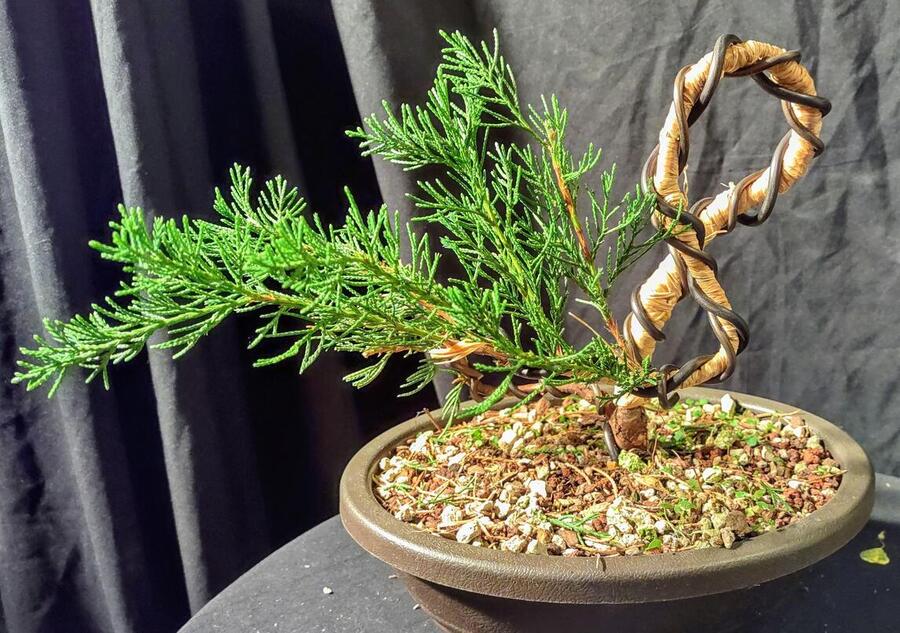
Characteristics of the Sea Green Juniper Bonsai
The Sea Green Juniper Bonsai possesses several distinctive characteristics that contribute to its allure and popularity. Here are some key characteristics of the Sea Green Juniper Bonsai:
Foliage: The Sea Green Juniper Bonsai features dense foliage composed of small, needle-like leaves. The foliage is vibrant green in color, adding a fresh and lively element to the bonsai’s appearance.
Compact Size: As a bonsai, the Sea Green Juniper is meticulously pruned and trained to maintain a miniature size. Its compact nature makes it suitable for indoor or outdoor display in small spaces, such as tabletops or garden settings.
Branching Structure: Sea Green Juniper Bonsai has a naturally elegant and intricate branching structure. The branches tend to grow in a horizontal or slightly drooping fashion, creating a sense of graceful movement and balance.
Bark Texture: The bark of the Sea Green Juniper develops a mature and visually appealing texture over time. It becomes rough and rugged, adding character and depth to the overall composition of the bonsai.
Drought Tolerance: Sea Green Juniper Bonsai, like its parent species, has a high tolerance for drought. It is adapted to withstand dry conditions, making it a suitable choice for those who may have occasional lapses in watering or live in drier climates.
Longevity: With proper care and maintenance, Sea Green Juniper Bonsai can live for many years. Its longevity allows bonsai enthusiasts to develop a long-term relationship with their tree, nurturing and shaping it over time.
Shaping Potential: Sea Green Juniper Bonsai is known for its responsiveness to shaping and pruning. With careful and skillful techniques, bonsai enthusiasts can create various styles, such as upright, cascade, or slanting, allowing for artistic expression and customization.
Outdoor Adaptability: While Sea Green Juniper Bonsai can thrive indoors, it also has the capability to grow outdoors, making it versatile for different environments and climates. However, it is important to consider the specific needs and climate requirements of your particular bonsai tree.
These characteristics make the Sea Green Juniper Bonsai a captivating choice for bonsai enthusiasts. Its vibrant foliage, compact size, and responsiveness to shaping techniques contribute to its aesthetic appeal and make it an enjoyable and rewarding tree to cultivate.
How to Grow a Sea Green Juniper Bonsai
Growing a Sea Green Juniper Bonsai can be a rewarding and fulfilling experience. Here are some steps to guide you in successfully growing and caring for your Sea Green Juniper Bonsai:
- Select a Healthy Tree: Select a Sea Green Juniper Bonsai seedling or a pre-bonsai tree from a reputable nursery or bonsai expert. Look for a tree with healthy leaves, robust roots, and a sturdy trunk.
- Choose the Right Pot and Soil: Select a bonsai pot or container that provides adequate drainage and is appropriate in size for your Sea Green Juniper Bonsai. Use a well-draining bonsai soil mix, specifically formulated for bonsai cultivation, to ensure proper water retention and aeration.
- Positioning and Light Requirements: Place your Sea Green Juniper Bonsai in a location that receives ample sunlight. Sea Green Junipers thrive in full sun to partial shade. Aim for a spot near a window or in a well-lit area if grown indoors, or provide a balance of sunlight and shade if grown outdoors.
- Watering: Proper watering is crucial for the health of your bonsai. Water your Sea Green Juniper Bonsai when the topsoil feels slightly dry to the touch. Avoid overwatering, as this can lead to root rot. Water thoroughly, allowing water to soak through the entire root system, and ensure that excess water drains out of the pot.
- Pruning and Shaping: Regular pruning is essential to maintaining the desired shape and form of your Sea Green Juniper Bonsai. Use sharp and clean bonsai pruning shears or scissors to carefully remove excess growth, shape branches, and encourage the desired structure. Prune during the appropriate season to avoid stressing the tree.
- Fertilization: Provide your Sea Green Juniper Bonsai with regular fertilization to supply essential nutrients. Use a balanced, slow-release bonsai fertilizer or a liquid fertilizer specifically formulated for bonsai. Follow the manufacturer’s instructions for application and frequency.
- Repotting: Repot your Sea Green Juniper Bonsai every 2 to 3 years to refresh the soil, promote root health, and prevent the tree from becoming root-bound. Repot during the spring before new growth emerges, using the appropriate bonsai soil mix and carefully trimming the roots.
- Protection from Extreme Conditions: Protect your Sea Green Juniper Bonsai from extreme weather conditions. If grown outdoors, provide shelter during severe cold or intense heat. If grown indoors, ensure proper humidity levels and protect from drafts.
- Monitor and Address Pests or Diseases: Regularly inspect your bonsai for signs of pests or diseases, such as spider mites, aphids, or fungal infections. Treat any issues promptly using appropriate organic or chemical remedies to prevent further damage.
- Enjoy the Journey: Growing a Sea Green Juniper Bonsai is a journey that requires patience and care. Embrace the process, observe the growth and changes, and take pleasure in the beauty of your bonsai tree.
By following these steps and providing the necessary care, you can cultivate a healthy and thriving Sea Green Juniper Bonsai that will bring you joy and serenity for years to come.
Benefits of the Sea Green Juniper Bonsai
The Sea Green Juniper Bonsai offers several benefits to bonsai enthusiasts and those who appreciate its beauty. Here are some key benefits of the Sea Green Juniper Bonsai:
1. Aesthetic Appeal: The Sea Green Juniper Bonsai is visually striking with its vibrant green foliage and graceful form. Its miniature size and intricate branching structure make it an attractive addition to any indoor or outdoor space, adding a touch of natural beauty and tranquility.
2. Stress Relief and Relaxation: Caring for a Sea Green Juniper Bonsai can be a therapeutic and calming activity. The process of tending to the tree, pruning, and shaping can help reduce stress and promote relaxation. The presence of a bonsai in your living or working space can create a serene and peaceful atmosphere.
3. Connection with Nature: You can introduce a piece of nature into your home or garden with the Sea Green Juniper Bonsai. It functions as a reminder of our connection to the natural world and instills a sense of appreciation for the natural world’s majesty.
4. Cultivation and Artistic Expression: Growing and shaping a Sea Green Juniper Bonsai allows for creative expression and the cultivation of artistic skills. As you prune, shape, and refine the bonsai, you can create unique compositions and develop your own personal style within the art of bonsai.
5. Educational and Therapeutic Value: The process of nurturing a Sea Green Juniper bonsai can lead to intellectual and spiritual development. You may increase your understanding of gardening, practice patience, and strengthen your sense of responsibility. It may also be used to teach kids about the environment, life cycles, and the value of taking care of living things.
6. Indoor and Outdoor Versatility: The Sea Green Juniper Bonsai can be grown both indoors and outdoors, depending on your preferences and available space. It is adaptable to different environments and can be enjoyed in apartments, offices, gardens, or balconies, bringing the beauty of bonsai to various settings.
7. Longevity and Legacy: Sea Green Juniper Bonsai may live for many years, even decades, if properly cared for. It provides the potential to leave a lasting legacy by passing down the joy and enthusiasm for the art of bonsai to future generations.
Overall, the Sea Green Juniper Bonsai provides aesthetic, emotional, and educational benefits. Its beauty, calming presence, and connection to nature make it a cherished addition to any space, enriching the lives of bonsai enthusiasts and admirers alike.
Styling and Design of the Sea Green Juniper Bonsai
The styling and design of the Sea Green Juniper Bonsai can vary depending on the artistic vision of the bonsai enthusiast. However, there are several common styling techniques and design principles that can be applied to create a visually appealing composition. Here are some popular styling approaches for the Sea Green Juniper Bonsai:
Formal Upright (Chokkan): This style features a straight, upright trunk with well-balanced branches radiating from it. The branches gradually decrease in size as they ascend, creating a pyramid-like shape. The Sea Green Juniper’s compact growth habit and dense foliage make it suitable for achieving a well-proportioned, formal upright design.
Informal Upright (Moyogi): The informal upright style aims to mimic the natural growth pattern of a tree. The trunk may have gentle curves and bends, and the branches exhibit more asymmetry and irregularity. The Sea Green Juniper’s flexible branches and delicate foliage lend themselves well to creating an organic and graceful informal upright design.
Slanting (Shakan): The bonsai trunk is inclined at an angle in the slanting style, creating the appearance of a tree growing against the wind or on a hill. The flexible branches of the Sea Green Juniper may be neatly arranged to compliment the slanted trunk, resulting in a dynamic and aesthetically intriguing arrangement.
Cascade (Kengai): Cascade style represents a tree growing on a cliff or near a water source, with its branches cascading downward. The Sea Green Juniper’s drooping growth habit and flexible branches make it well-suited for cascading designs. The branches can be carefully trained and styled to flow gracefully downward, creating a sense of drama and movement.
Group Planting (Yose-ue): Group planting involves creating a composition with multiple bonsai trees planted together in a harmonious arrangement. Combining Sea Green Juniper Bonsai with other compatible species can result in a visually striking and balanced display. The Sea Green Juniper’s compact size and dense foliage can contribute to the overall cohesion of the group planting.
When designing the Sea Green Juniper Bonsai, it’s essential to consider the principles of balance, proportion, and harmony. Aim for a balanced distribution of branches, ensuring that they do not crowd each other or create a visual imbalance. Maintain harmony between the trunk, branches, and foliage, seeking a coherent and aesthetically pleasing overall form.
Ultimately, the styling and design of the Sea Green Juniper Bonsai provide an opportunity for creative expression and artistic interpretation. Experimenting with different styles and designs while respecting the natural characteristics of the tree can result in a visually captivating and harmonious bonsai composition.
How to Care for and Maintain a Sea Green Juniper Bonsai
Caring for and maintaining a Sea Green Juniper Bonsai requires attention to various aspects of its growth and well-being. Here are some essential care guidelines to keep your Sea Green Juniper Bonsai healthy and thriving:
- Light Requirements: Place your Sea Green Juniper Bonsai in a location that receives ample sunlight. It prefers full sun to partial shade. If grown indoors, provide the bonsai with bright, indirect light near a window. Rotate the bonsai periodically to ensure even exposure to sunlight.
- Watering: Proper watering is crucial for the health of your bonsai. Water the bonsai when the topsoil feels slightly dry to the touch. Avoid overwatering, as it can lead to root rot. Thoroughly water the bonsai, allowing water to soak through the entire root system, and ensure that excess water drains out of the pot.
- Humidity: Sea Green Juniper Bonsai thrives in moderate humidity levels. To increase humidity, you can place a humidity tray filled with water near the bonsai or use a room humidifier. Mist the foliage occasionally, especially during dry seasons or in heated indoor environments.
- Fertilization: Feed your Sea Green Juniper Bonsai with a balanced, slow-release bonsai fertilizer or a liquid fertilizer specifically formulated for bonsai. Follow the manufacturer’s instructions for application and frequency. Fertilize during the growing season, typically from spring to early autumn.
- Pruning and Shaping: Regular pruning is essential to maintaining the desired shape and form of your Sea Green Juniper Bonsai. Use sharp and clean bonsai pruning shears or scissors to carefully remove excess growth, shape branches, and encourage the desired structure. Prune during the appropriate season to avoid stressing the tree.
- Wiring: Wiring can be used to shape and position branches in the desired direction. Use bonsai wire of an appropriate thickness and carefully wrap it around branches, taking care not to damage the bark. Monitor the wire regularly to prevent it from cutting into the branches, and remove it once the branches have set in the desired position.
- Repotting: Repot your Sea Green Juniper Bonsai every 2 to 3 years to refresh the soil, promote root health, and prevent the tree from becoming root-bound. Repot during the spring before new growth emerges. Trim the roots moderately, and use a well-draining bonsai soil mix specifically formulated for bonsai.
- Protection from Extreme Conditions: Protect your Sea Green Juniper Bonsai from extreme weather conditions. If grown outdoors, provide shelter during severe cold or intense heat. If grown indoors, protect the bonsai from drafts and sudden temperature fluctuations.
- Pest and Disease Control: Inspect your bonsai frequently for signs of parasites such as spider mites, aphids, and scale insects. Treat infestations immediately with the appropriate organic or chemical treatments. In addition, observe the bonsai for signs of diseases, such as fungal infections, and treat them as necessary.
- Regular Maintenance: In addition to the specific care tasks mentioned above, regularly observe your Sea Green Juniper Bonsai for any signs of stress, nutrient deficiencies, or other issues. Attend to the tree’s overall health by removing dead or yellowing foliage, maintaining cleanliness, and ensuring proper airflow around the bonsai.
By following these care guidelines, you can provide the necessary attention and support to keep your Sea Green Juniper Bonsai healthy, beautiful, and thriving for years to come. Remember to adapt the care routine based on your specific environmental conditions and the unique needs of your bonsai.
Sea Green Juniper Bonsai Care sheet
| Aspect | Care Tips |
| Watering | Water when the topsoil feels slightly dry to the touch. Avoid overwatering. Thoroughly water, allowing water to drain out of the pot. |
| Sunlight | Place in a location that receives ample sunlight. Full sun to partial shade is preferred. Rotate the bonsai periodically for even sun exposure. |
| Humidity | Moderate humidity is ideal. Use humidity trays or room humidifiers. Mist the foliage occasionally. |
| Fertilization | Feed with balanced, slow-release bonsai fertilizer or liquid bonsai fertilizer during the growing season. Follow manufacturer’s instructions. |
| Pruning | Regular pruning is necessary. Use sharp shears to remove excess growth, shape branches, and maintain desired form. Prune during the appropriate season. |
| Shaping | Shape branches to achieve desired form. Use wiring if necessary. Monitor the wire to prevent damage and remove once branches set in position. |
| Wiring | Use bonsai wire to shape and position branches. Carefully wrap without damaging the bark. |
| Repotting | Repot every 2 to 3 years in spring. Trim roots, use well-draining bonsai soil mix. |
| Protection from Extreme Conditions | Provide shelter during severe cold or heat. Protect from drafts and sudden temperature fluctuations if grown indoors. |
| Pest and Disease Control | Regularly inspect for pests and diseases. Treat infestations promptly with appropriate remedies. |
| Regular Maintenance | Monitor overall health. Remove dead or yellowing foliage. Maintain cleanliness and proper airflow. |
Remember to adjust the care routine based on your specific environmental conditions and the needs of your Sea Green Juniper Bonsai. Regular observation and attentive care will ensure the well-being and vitality of your bonsai tree.
Conclusion
The Sea Green Juniper Bonsai is a remarkable bonsai variety that allows us to bring a piece of nature’s beauty into our lives. By embracing the art of bonsai cultivation and nurturing this miniature tree, we can find joy, inspiration, and a deeper appreciation for the wonders of the natural world. So why not embark on your bonsai journey with the Sea Green Juniper Bonsai and witness the transformation of a living masterpiece right before your eyes?
FAQ:
Q: What is a Sea Green Juniper Bonsai?
A: Sea Green Juniper Bonsai is a bonsai tree variety known for its vibrant green foliage and compact growth habit.
Q: How tall does a Sea Green Juniper Bonsai grow?
A: It typically grows to a height of 6 to 12 inches (15 to 30 cm).
Q: Can I keep my Sea Green Juniper Bonsai indoors?
A: Yes, it can be kept indoors with proper sunlight and humidity.
Q: How often should I water my Sea Green Juniper Bonsai?
A: Water when the topsoil is slightly dry, avoiding overwatering.
Q: How often should I fertilize my Sea Green Juniper Bonsai?
A: Fertilize during the growing season using a balanced bonsai fertilizer.
Q: When should I prune my Sea Green Juniper Bonsai?
A: Prune in the spring or early summer to maintain shape and form.
Q: How frequently should I repot my Sea Green Juniper Bonsai?
A: Repot every 2 to 3 years in the spring to promote root health.
Q: How can I protect my Sea Green Juniper Bonsai from pests and diseases?
A: Regularly inspect for pests, provide good airflow, and take preventive measures.
Q: Can I grow Sea Green Juniper Bonsai from seeds?
A: Yes, but it requires time and patience. Starting with young plants or pre-bonsai material is more common for faster results.
Also Read:



